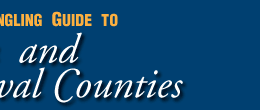CONTACT US:
Florida Fish and Wildlife
Conservation Commission
Fish and Wildlife
Research Institute
100 Eighth Avenue SE
St. Petersburg, Florida 33701
727-896-8626
|
|
|
City of Jacksonville
Parks and Recreation
214 N. Hogan Street
Third Floor
Jacksonville, Florida
32202
904-630-2489
|
|
|


|
|
This project was funded in part by a grant awarded by the and .
|
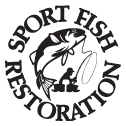
|
|
Additional funding for this project was obtained through the .
|
|
|

|
NORTH ATLANTIC RIGHT WHALE
North Atlantic right whales migrate during winter months (November 15 to April 15) to the coastal waters of Georgia and Florida, which is the only known calving area for these critically endangered whales. Adult right whales can be 55 feet long and calves are 15-20 feet. They have black skin; broad, paddle-shaped flippers; no dorsal fin on their back; and produce a V-shaped blow. Adults have light colored patches of wart-like raised skin on their heads.
If you see a right whale(s), slow your vessel and do not attempt to approach. Cautiously move 500 yards or more away from the whale(s). Call FWC’s Wildlife Alert Hotline, 888-404-FWCC (888-404-FWCC) as soon as possible to report the location or GPS position of your sighting. If you sight an entangled or injured right whale, contact the U.S. Coast Guard on VHF channel 16 to report the sighting time, GPS position or physical location of the whale, direction of the whale’s movement, and a description of the animal’s entanglement or injury. If possible, maintain visual contact with the entangled or injured whale until help arrives.
For more information about North Atlantic right whales in Florida waters, visit FWC's Right Whale page.
|
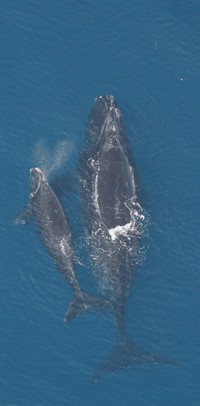
|
SEA TURTLES
Florida’s waters are home year-round to five species of sea turtles. All are protected by state and federal regulations. Sea turtles surface to breathe and occasionally bask at the surface, which makes them vulnerable to boat strikes. During their nesting season, May to October, sea turtles may be concentrated near beaches. The sea turtle most commonly seen in coastal waters is the loggerhead, followed by the green turtle, Kemp’s ridley, and hawksbill. A fifth species, the leatherback, is typically seen in deep offshore waters. Floating sargassum, often found off Florida’s east coast, is important for juvenile sea turtles, where they spend their first few years maturing. |
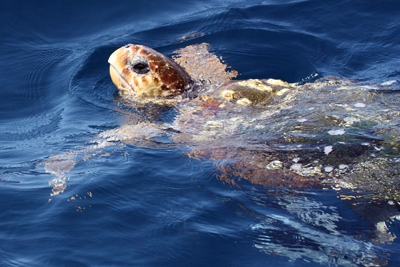
|
You Can Help:
- Keep a sharp lookout for turtles near the surface, especially on sunny days.
- Maintain a moderate vessel speed in shallow water and near beaches.
- Keep beaches and waterways clean and free of pollution, such as fishing line, which can entangle sea turtles.
- Protect seagrass beds. Avoid creating propeller scars
- Support efforts to protect sea turtles and their habitats
- Report injured or dead sea turtles to the FWC’s Wildlife Alert Hotline at 888-404-FWCC (404-3922).
For more information about sea turtles, visit FWC's Sea Turtle Research Program.
|
MANATEES
The Florida manatee’s year-round range is typically restricted to Florida waters including both fresh and salt water. In warmer months some manatees may venture as far north as New England and as far west as Texas. The Florida manatee has a large, spindle-shaped body with a round, paddle-shaped tail and relatively short front flippers. As adults, they grow to an average length of 10 feet and 1,200 pounds.
Collisions with watercraft are a critical source of manatee injury and are the single greatest known cause of mortality. An important conservation objective of FWC is to reduce human-caused annual manatee mortality by minimizing human related threats. |
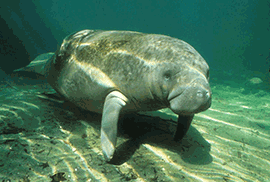
|
You Can Help:
- Observe and follow all speed zone signs.
- Slow down. Reducing speed allows boaters to avoid manatees.
- Use marked channels whenever possible. Channel depth reduces the likelihood of pinning or crushing manatees.
- Wear polarized glasses. Polarized lenses make it much easier to see objects beneath the surface and the “swirling” that occurs when a manatee dives.
- Designate a person on board to look out for wildlife, other boaters, swimmers, or obstructions when the vessel is underway
- Stow trash and properly discard monofilament fishing line. Manatees may swallow or become trapped in lines and other plastic debris.
- Obey state and federal laws that make it illegal to harass, capture, hunt, or kill a manatee. To report a dead or distressed manatee or to report violations, call FWC's Wildlife Alert Hotline at 888-404-FWCC (404-3922).
For more information about manatees, visit FWC's Manatee Research Program.
|
BIRDS OF THE AREA
Despite environmental pressures from growth and development in the region, Duval and Nassau Counties attract a remarkable variety and number of birds. Beaches, sand bars and inlets provide nesting areas for species of conservation concern. Mudflats and salt marshes in shallow waters provide a bountiful feeding ground for resident, migrant, and wintering shorebirds and wading birds. Open waters are habitat for seabirds and ducks. Nesting ospreys and bald eagles can be found all along the Nassau and Duval County coastline.
|
 |
Maintaining these bird populations close to a growing metropolitan area is challenging. Many species are declining, and some have virtually disappeared due to loss and disruption of habitat. By being aware and by observing a few simple measures, you can help prevent the decline of these birds and keep them around for our and future generations to enjoy.
Especially vulnerable are the many coastal species of birds that nest directly on bare sand and on oyster rakes. The eggs and the chicks are camouflaged, making them difficult for humans to see. If beach visitors come too close, adult birds will fly off their nests, exposing eggs and chicks to sun damage or predation. Birds see dogs as predators and will be disturbed by dogs earlier than by people.
|
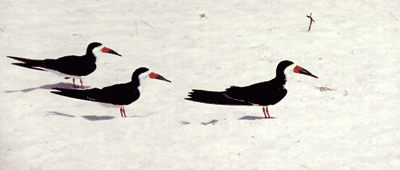
© Chris Anderson
|
| Common nesting birds of coastal Nassau and Duval counties |
| Wading Birds (Herons, Egrets and Wood Storks): These graceful, long-legged birds stalk the shallows of marshes and nest in colonies in trees near the water. Most commonly seen are great blue herons, tricolored herons, snowy egrets, and great egrets. Wood storks are unique because of their gray, featherless heads. Wood storks have been declining in numbers and are federally listed. |
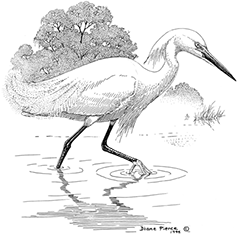
|
| Terns And Skimmers: These sporty flyers make shrill calls as they dive for fish or fly along the coast. In spring, terns and black skimmers lay their eggs on the bare sand. The chicks and eggs are hard to see; posts and twine are placed around them to prevent them from being crushed. Disturbances of the nesting birds can cause harm to chicks and eggs. Gull-billed terns, and tiny least terns are declining in numbers and need our help. The elegant black-and-white skimmers fly just above the surface of shallow water, trailing their lower beaks in the water to snap up small fish. |
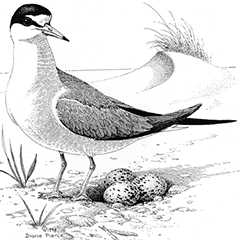
|
| American Oystercatchers: Black-and-white oystercatchers find small mussels and clams to pry open with their bright red beak. They nest on oyster rakes and will abandon eggs and chicks if disturbed. |
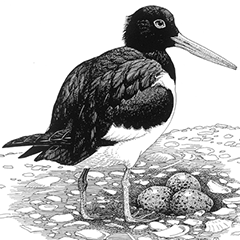
|
| Shorebirds: These small energetic birds probe the beach sand for food. Though some shorebirds nest in Florida, most are migratory or winter residents. Flocks of shorebirds gather near the waterline to feed and rest before their long migrations. These include red knots, which stop in the region to refuel during their return from Tierra del Fuego to the Arctic; one of the longest migrations in the world. |
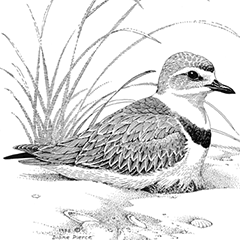
|
| Eagles And Other Raptors: Bald eagles, ospreys, as well as hawks and falcons are found in this region. Nests of eagles and ospreys are usually near water, built high in trees. |

|
Some important bird sites of Nassau/Duval counties
Nassau Sound: On its north and south side, the beaches of Amelia Island and Little Talbot Island state parks offer nesting habitat for least terns, Wilson’s plovers, black skimmers, gull-billed terns and American oystercatchers. Please respect posted nesting areas and encourage others to do so. Dogs are not allowed on the state parks’ beaches. Some small islands in Nassau Sound are designated Critical Wildlife Areas and landing is discouraged during nesting season, April through August.
Intracoastal Waterway, Tidal Creeks And Marsh Sloughs: American oystercatchers nest on low sandbars and oyster rakes. Avoid high wakes and stay at a distance from marked nesting areas and from vocal birds. Trees along the water can harbor heron and egret rookeries. Admire the spectacle of these showy birds from a distance: if a young bird is scared and falls off the nest, the parents will not feed it and it will die.
Fort George Inlet: On its south side, the dunes of Huguenot Memorial Park harbor the largest colony of nesting royal terns and laughing gulls on Florida’s Atlantic coast. The flats and bars in the inlet are a known stopover site for migrating red knots, where they feed on coquina clams. You can help these birds achieve a successful migration by staying at a distance from flocks of birds.
For more information about birds of Nassau and Duval Counties, visit Duval County Audubon Society. The Great Florida Birding Trail has an extensive list of location to view birds in Nassau and Duval counties, as well as the rest of Florida.
|
If you have any questions, comments, or suggestions about this Web site, please e-mail us at Boating_Guides@MyFWC.com.
Would you like to receive notices of changes to this Web site and the Boating and Angling Guide to Nassau and Duval Counties? If so, please e-mail us and include SUBSCRIBE-DUVAL in the subject line.
|

